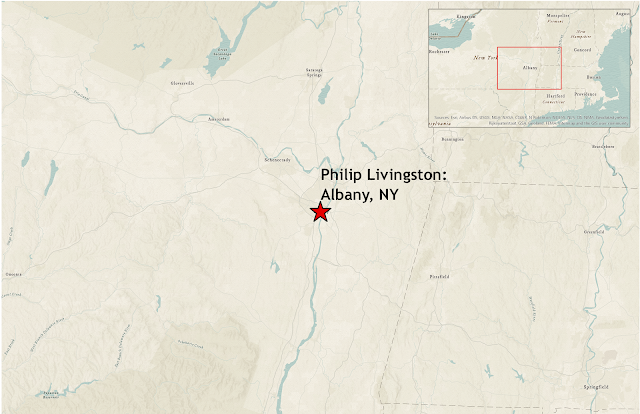Founding Fathers - Philip Livingston
Philip Livingston
Born: January 15, 1716 (Albany, New York)
Died: June 12, 1778 (York, Pennsylvania)
This week we dig into the life and history of the fourth and final signer from New York. Born in 1716, Philip Livingston was raised in a position of privilege among a family full of wealth and political influence. His father, also named Philip, was the second lord of Livingston Manor, an estate of some 160,000 acres just south of Albany, NY and his mother, Catherine Van Brugh, was the daughter of Albany's mayor. As the fifth son, young Philip was not in line to inherit the title but he did gain much of the esteem (and not a little wealth) from his family. He spent his childhood splitting time between his father's townhome in Albany and the manor house in the country, and when it was time to attend college he went to Yale, where he graduated in 1737 at the age of 21. Philip moved to Manhattan and quickly became successful as an importer and merchant. He also became a family man, marrying Christina Ten Broeck in 1740 and eventually having nine children.
Establishing a reputation for public service, Philip Livingston helped found King's College (now Columbia) in 1746 and later assisted in organizing the New York Society Library in 1754. That same year, as the French and Indian War was brewing, Livingston became a New York City alderman and attended the Albany Congress, which submitted a plan to King George III to unite the colonies for common defense against the Indians. Although the idea was rejected, it signified the recognition that there was strength to be found in joining forces. Livingston profited significantly by supplying the war effort over the following years while also being elected as a delegate to the New York assembly, and in 1764 he purchased a 40 acre estate in Brooklyn Heights across the East River. Although he attended the Stamp Act Congress in 1765 and was politically aligned with those who believed that the colonists should only be taxed with their consent, his preference for orderly and respectful protests put him at odds with revolutionary groups. By 1768 he had helped establish the city's first benevolent organization, known as St. Andrew's Society, as well as the a chamber of commerce. Livingston was sent to the New York legislature as a delegate from Livingston Manor, but in 1769 he was denied his seat because he was not a resident there. That decision didn't ultimately matter, however, as the royal governor dissolved the body later that year. In 1771, during a brief gap between elected public positions, Livingston continued impacting his city as he became one of the original governors over the New York Hospital.
Philip Livingston's participation in the cause of freedom included joining the New York Committee of Correspondence as well as the Committee of Sixty, which helped govern until an assembly could be elected while also selecting delegates to the First Continental Congress. He was selected to attend, although he had to divide his attention between Philadelphia and New York, where he was also elected as the president of the New York Provincial Assembly. Livingston joined his younger brother, William, in signing the Olive Branch Petition in 1775, but by the time it was rejected and it was time to vote on the question of independence, William had been called away to command the New Jersey militia. Philip himself was absent when the decision was made, likely a deliberate choice as the New York delegates were not authorized to vote on the matter. He was, however, able to sign once the motion carried unanimously. When the British captured New York, their army occupied both of the Livingston properties while the family fled to the city of Kingston, where the state government had moved. The Manhattan home was used as a barracks, while the Brooklyn Heights was set up to serve as a hospital. Before the British burned Kingston to the ground, New York was able to craft a state constitution early in 1777, and Livingston was elected to the Senate. He still retained his seat in Congress, and during the summer of 1778 he was attending a session in York, PA, when he died suddenly of unexplained causes. He was just the third signer to die, and his burial in York was attended by the remaining representatives.
The signature of Philip Livingston can be found as the second name on the fifth column beneath the Declaration of Independence.



Comments
Post a Comment